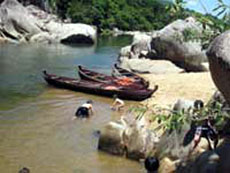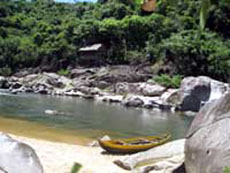Thousands of rocks in different shapes and sizes create the uniqueness of Ham Ho, also known as the "Forest of Stone", in the central province of Binh Dinh.
 Located in Tay Son District, around 50km east from Quy Nhon City, Ham Ho is situated at the confluence of two tributaries of the Con River. The junction has created a unique landscape for the whole area of Ham Ho, which spreads across a 150,000sq.km area. Greenery, rocks and water together in harmony, create an impressive natural landscape. Pure streams reflecting the green trees look like smooth bands of silk, curving round the rocks.
Located in Tay Son District, around 50km east from Quy Nhon City, Ham Ho is situated at the confluence of two tributaries of the Con River. The junction has created a unique landscape for the whole area of Ham Ho, which spreads across a 150,000sq.km area. Greenery, rocks and water together in harmony, create an impressive natural landscape. Pure streams reflecting the green trees look like smooth bands of silk, curving round the rocks.
The name "Forest of Stone" originates from the vast quantities of rocks at the site. Not only is it surrounded by giant limestone cliffs, there are uncountable stones in the streams, which have different names due to their shapes such as Hon Vo Ruou (The Wine Jar Stone), Hon Ban Co (The Chessboard Stone) and Hon Dau Chan (The Footprint Stone).
Although there is a path leading to the site, most tourists prefer to get there by water. With a cost of VND30,000 per person, the visitors can take a boat gently down a small stream under the thick shadow of trees, which one tourist dubbed a "green tunnel".
"I felt like I was visiting a tunnel of dreams created by the thick leaf canopies with the sound of water murmuring through rocks, birds singing and wind playing with the trees," Hai Thach, a forty-something visitor said.
Floating on the water brought a different feeling to Thu Ha, a visitor from Da Nang. "Although the boat is not a traditional Venetian gondola, I felt like I was in Venice," she said.
A bright, awe-inspiring scene of giant cliffs and curving streams appears as the visitors exit the "green tunnel".
From here, the visitors can disembark and start their journey of discovery in the wild beauty of Ham Ho. By wading through the stream and climbing over many huge rocks to reach the river’s source, the visitors will have the chance to witness the untouched natural beauty of the Hai and Ba waterfalls, the Misty Summit and the Sac and Ba chasms.
 "I felt dizzy. The stream filled with rocks of different shapes and sizes, captured the imagination of everyone. Some stones looked like a herd of elephants, some looked like galloping horses, while some others looked like huge crocodiles," Thach commented.
"I felt dizzy. The stream filled with rocks of different shapes and sizes, captured the imagination of everyone. Some stones looked like a herd of elephants, some looked like galloping horses, while some others looked like huge crocodiles," Thach commented.
The unique terrain in Ham Ho has also created several ponds that make ideal natural swimming pools. However, the tourists favourite is a pond called Vung Trau Nam (Buffalo’s Pond), where "the stream bed is not too deep, the shore slope gentle and the water cool and clear", teenager Minh Thien said.
Palm-leaf-roofed stilt houses are scattered alongside the stream, offering the tourists a place to rest and eat. Located on the cliffs, some stilt houses are ideal places to witness the landscape from above. Otherwise the visitors can choose any bed-sized rock to take a rest.
"The stone bed is quite hard, but it is quite cool. We don’t ask for anything other than that on such a hot summers day," a young tourist said.
The Ham Ho site also offers trekking tours for those who are interested in discovering the jungle. Tourists can select a one-day or an overnight tour.
Hai Khoa, a student at Quy Nhon University, said he experienced a night in the jungle last year with a group of his classmates.
Khoa and his friends have visited the site several times because "the terrain of Ham Ho suits young tourists who are eager to discover and strong enough to climb the cliffs".
The temperature in Ham Ho is lower than other neighbouring areas, another reason why a huge number of tourists flock to the site during the summer. However, the locals suggest that Ham Ho is at its best in the spring, when the jungle is full of new life and the climate is fit for walking and picnics.
In the flooding season, visitors can witness schools of fish swimming upstream to lay their eggs. The fish sometimes leap into the air as they battle the current. That’s why there is a waterfall in Ham Ho called Thac Ca Bay, which means flying fish.
According to Nguyen Kien Trung, a tourist guide of the Quy Nhon-based Central Tourism Company, the Ham Ho tourist site welcomes thousands of visitors during the holidays. "However, foreign tourists make up a very small percentage," he said, without giving an exact figure.
When visiting Ham Ho, visitors should not ignore the local specialities, such as crispy fried stream fish served with wild vegetable and rice pancake, roasted sugarcane bird (a kind of bird only lives in the sugarcane farms around the site) and snails. Such tasty delicacies can be found at the Hoa Loc Vung restaurant at the site.
Trung has revealed that the local authority is planning to build a cable car system at Ham Ho, in an attempt to attract more tourists. "The cable car will offer visitors the chance to contemplate the imposing landscape of the area from above," Trung said.